How to Check Battery Cycle Count on Any iPhone in Seconds
Find out how many times your iPhone's battery has cycled—check your battery's health in just a few quick steps.
Key Takeaways:
- Cycle count measures how many full charges your iPhone battery has completed, helping track long-term wear even if you charge in short bursts.
- Monitoring battery cycle count lets you anticipate performance drops, so you can plan a replacement before your iPhone starts slowing down.
- iPhone 15 and newer with iOS 17.4+ show cycle count in Settings, under General > About > Battery—no third-party tools needed.
- Older iPhones require workarounds like PowerUtil or analytics logs, since iOS doesn’t show battery cycle data directly in Settings.
- Consider replacing the battery if your cycle count is high and capacity dips, especially if you’re noticing slower performance or rapid battery drain.
Is your iPhone starting to feel older than it should? If so, keeping an eye on your iPhone’s battery health is a good way to ensure your phone continues to work well. One of the easiest ways to check on your battery is by looking at its cycle count—that’s the number of times your battery has been fully charged and discharged.
Knowing this number can help you figure out when you might need a battery replacement. That way, you’re not surprised one day by a phone that dies too quickly. In this guide, I’ll show you step-by-step how to check your iPhone’s battery cycle count, whether you’ve got the latest model or one that’s a few years old, no matter which version of iOS you’re running.
Table of Contents
- What is the Battery Cycle Count in an iPhone?
- Why Check Your iPhone's Battery Cycle Count?
- How to Check Battery Cycle Count on iPhone 15, iPhone 16, and iPhone 16e
- How to Check Battery Cycle Count on iPhone 14 or Earlier
- Using Third-party Apps to Check Battery Cycle Count
- Video: How to Check iPhone 15 Battery Cycle Count
- When Should You Replace Your iPhone Battery?
- Tips to Help Your iPhone's Battery Last Longer
- Keep an Eye on Your iPhone's Battery Health
What is the Battery Cycle Count in an iPhone?
Think of your battery cycle count as your iPhone’s way of keeping track of how much work its battery has done over time. It’s not just about charging from 0% to 100% in one shot—instead, every time you use and recharge bits of your battery that add up to 100%, that counts as one cycle. So, you might use 70% one day and 30% the next; together, that’s a full cycle, even if you never let your phone hit zero.

For example:
- On day one, you use 70% of your battery and recharge to 100%.
- On day two, you use 30% and recharge again.
- Together, that’s 70% + 30% = one full cycle.
These cycles accumulate gradually, whether you charge your iPhone once or multiple times in a day.
Why Check Your iPhone’s Battery Cycle Count?
Your iPhone’s battery cycle count is basically a window into your battery’s health and how much life it has left. Like any lithium-ion battery, your iPhone’s battery can only go through a certain number of cycles before it starts to lose its capacity. In other words, the more cycles you rack up, the closer you get to needing a battery replacement. Here’s what Apple says about it:
- iPhone 14 and earlier: Designed to retain up to 80% of original capacity after 500 cycles.
- iPhone 15 and later: Designed to retain up to 80% after 1000 cycles.
Checking your iPhone’s battery cycle count regularly can help you:
- Keep track of how battery of your iPhone is aging
- Decide when it’s time to replace your battery
- Make smarter choices if you’re selling or buying a used iPhone
- Adjust how you charge your phone to slow down battery wear
How to Check Battery Cycle Count on iPhone 15, iPhone 16, and iPhone 16e
If you’ve got an iPhone 15, 16, or 16e running iOS 17.4 or newer, Apple has made it much easier to see your battery’s cycle count. Here’s how:
- Open the Settings app.
- Go to General > About.
- Scroll down to the Battery section.
- Find Cycle Count—this number shows how many cycles your battery has completed.
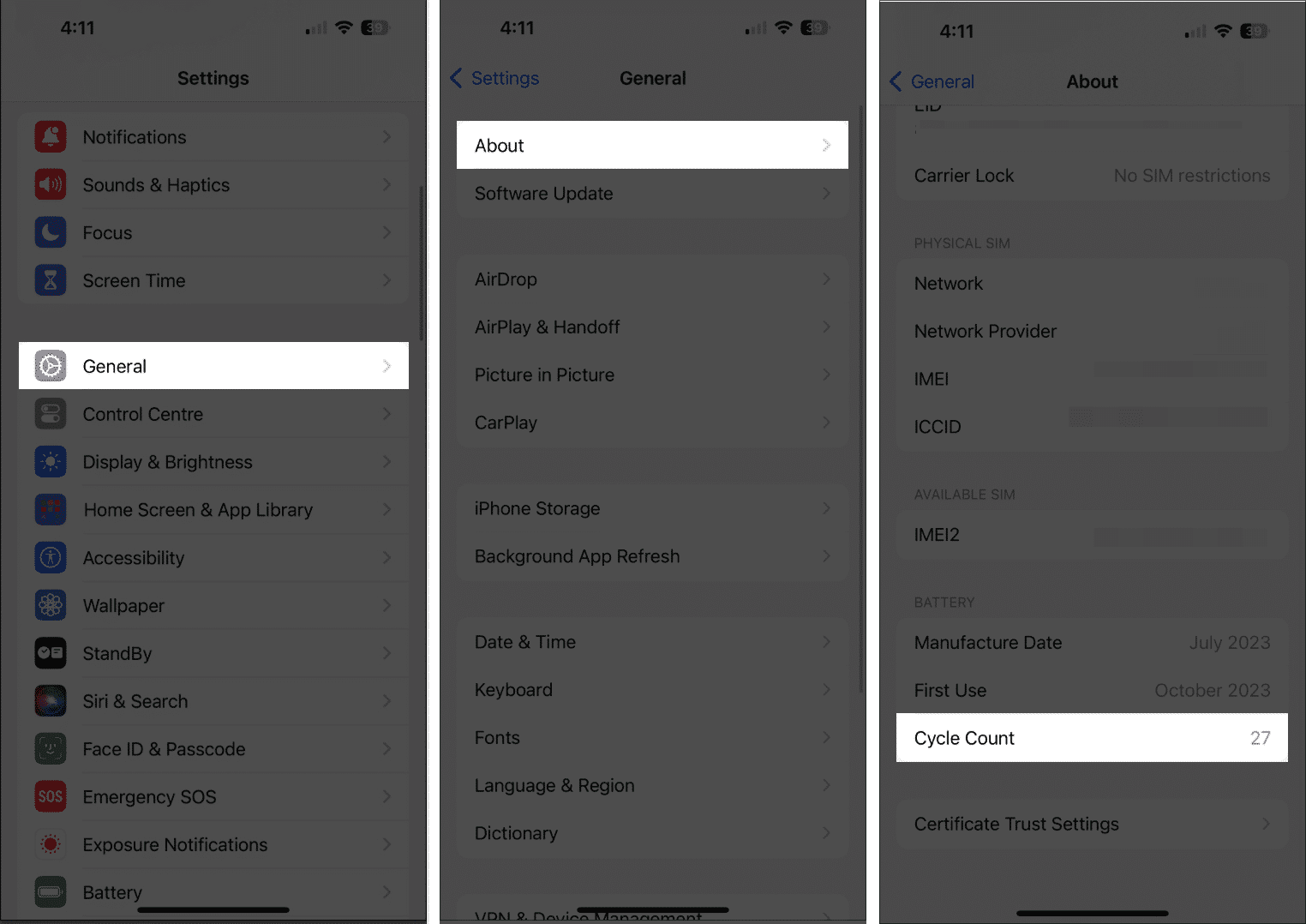
How to Check Battery Cycle Count on iPhone 14 or Earlier
On iPhone 14 and earlier, the cycle count is still recorded by your device, but Apple does not display it in the Settings app. That’s why you need to use a shortcut or manually search your analytics data to find this information.
Method 1: Using the PowerUtil Shortcut
- Download the PowerUtil shortcut on your iPhone.
- Tap Add Shortcut.
- Open Settings > Privacy & Security > Analytics & Improvements.

- Tap Analytics Data and select the latest file (with today’s date).
- Tap the Share icon.
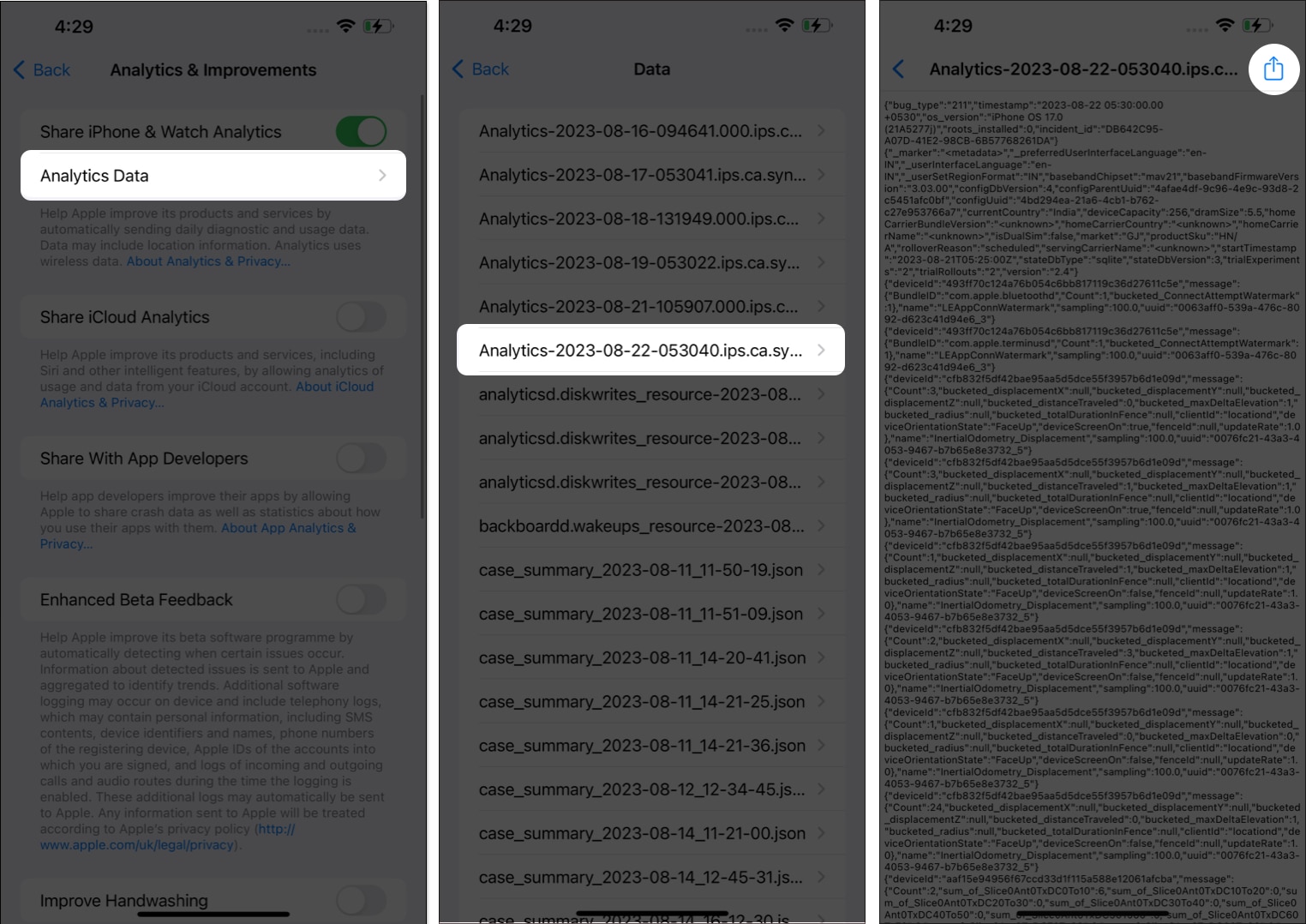
- Choose PowerUtil from the Share Sheet.
- Grant any necessary permissions.
- The shortcut will display your battery’s cycle count and other stats.
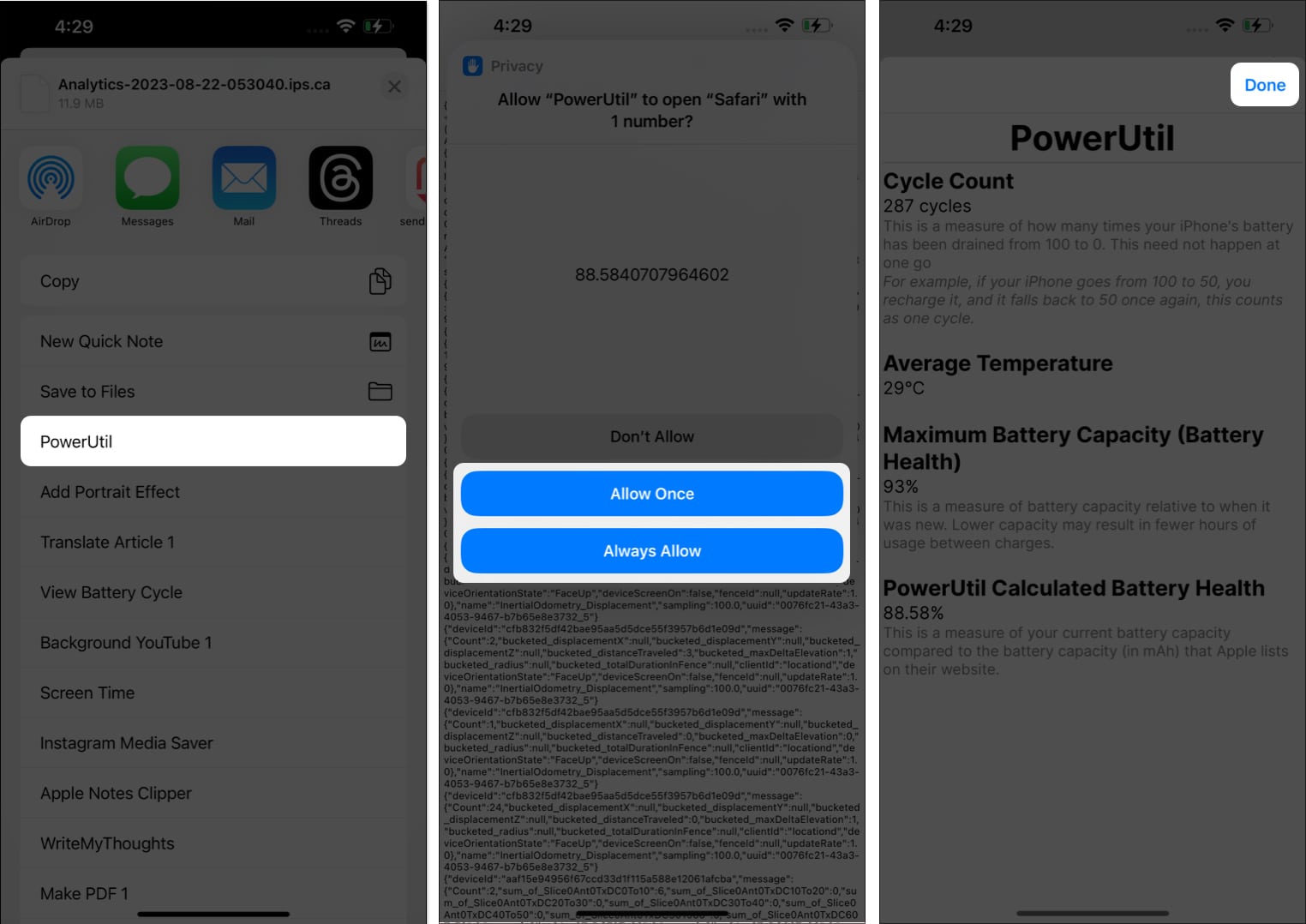
Method 2: Manually Checking Analytics Data
If you prefer not to use a shortcut, you can extract the cycle count manually:
- Open Settings > Privacy & Security > Analytics & Improvements.
- Tap Analytics Data and select the latest file.
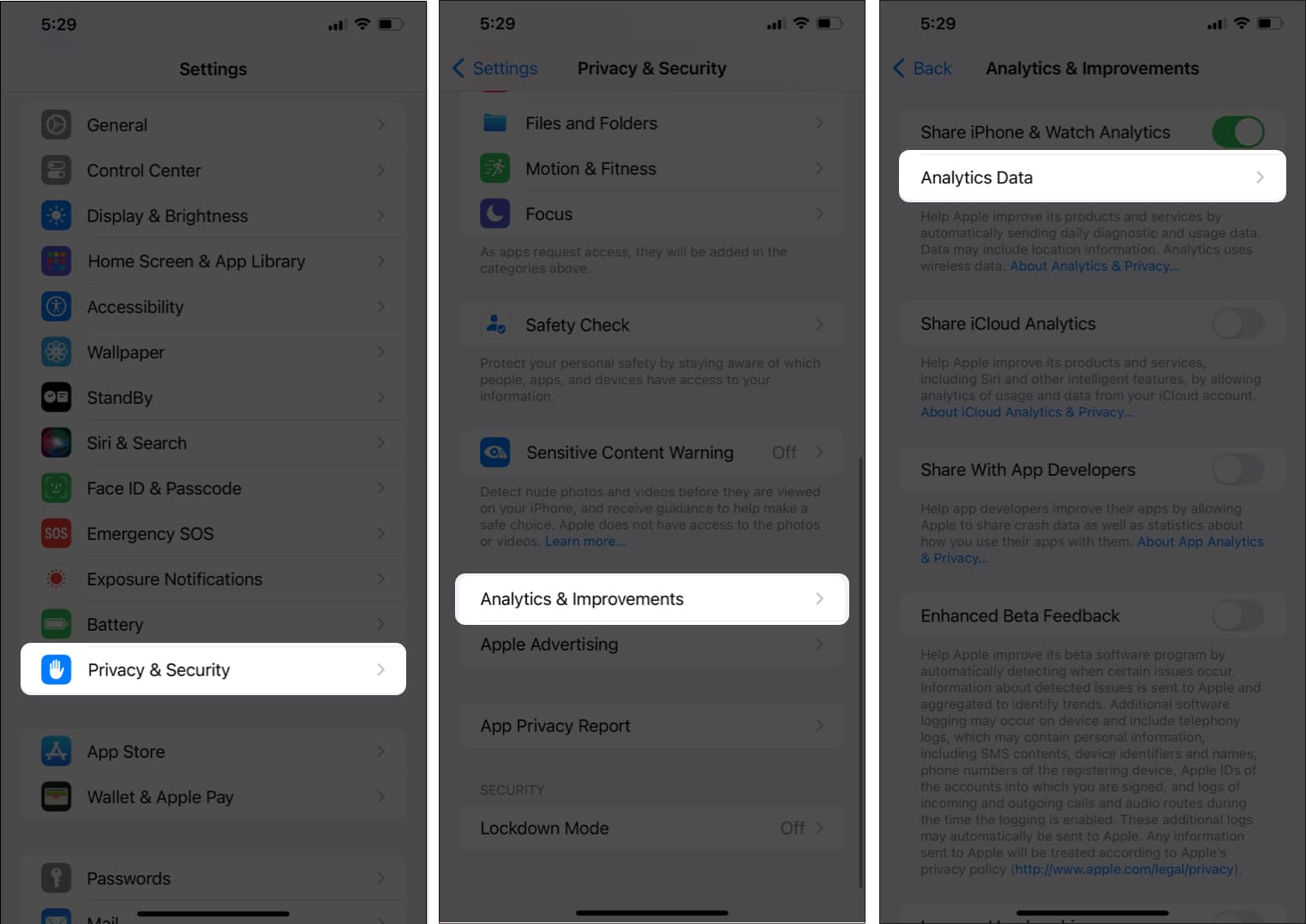
- Tap the Share icon and copy the data.
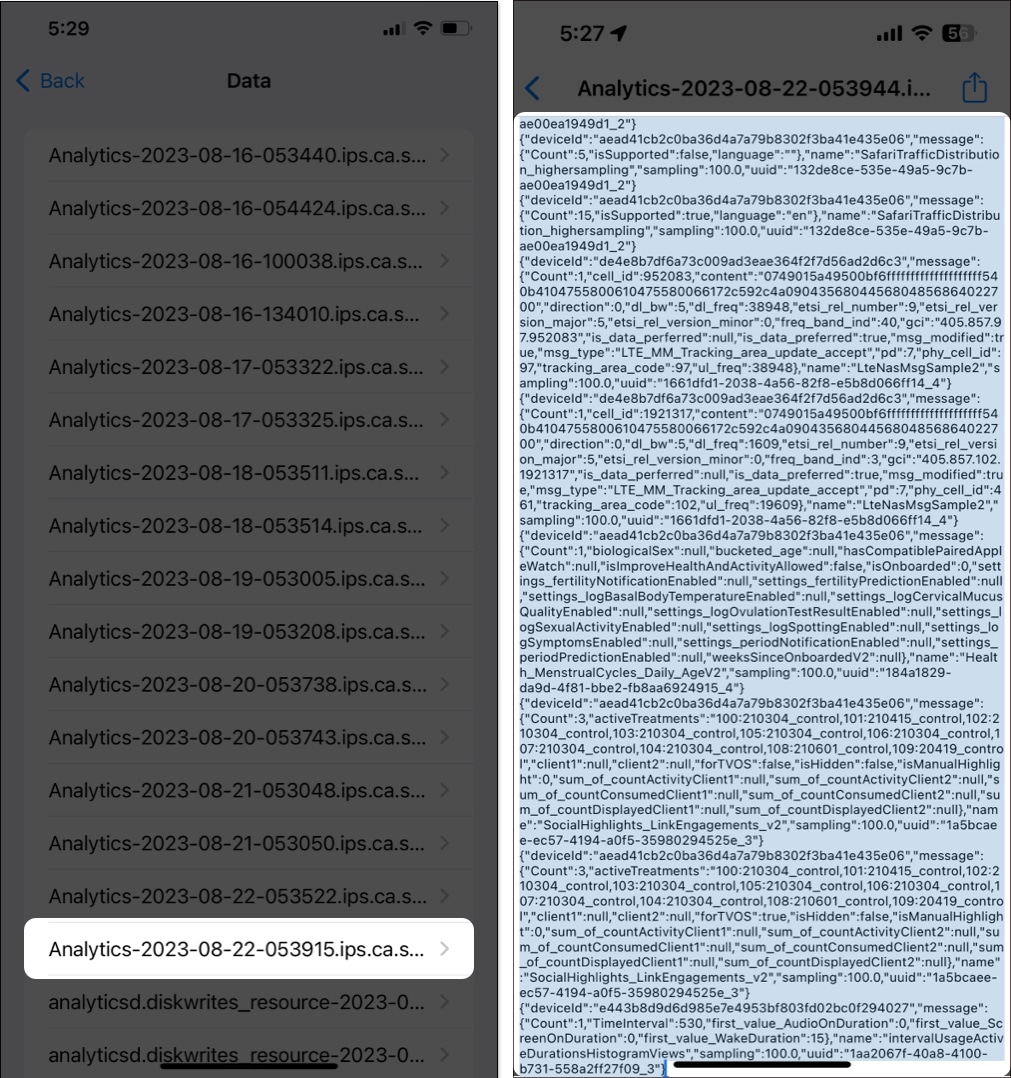
- Paste it into the Notes app.
- Use the Find in Note feature to search for last_value_CycleCount.
- The number next to this entry is your battery’s cycle count.
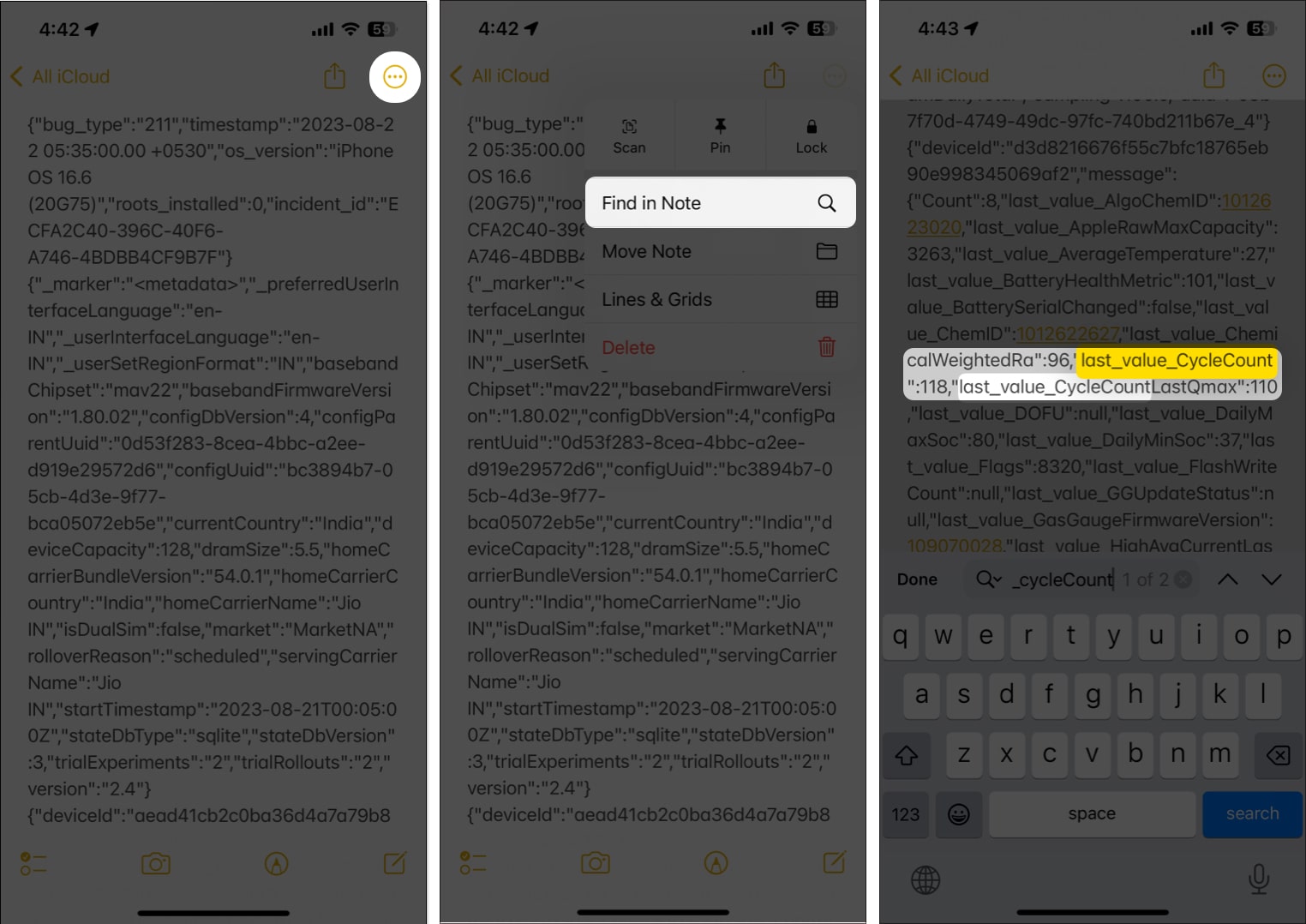
Using Third-party Apps to Check Battery Cycle Count
If you want a quicker or more visual way to check your iPhone’s battery cycle count—especially if you have an older model—there are some third-party apps that can make things easier. These apps often give you extra details about your battery’s health and come with user-friendly dashboards. Just keep in mind that because of iOS privacy rules, some apps might not be able to pull up all the info directly from your device and could require you to connect your iPhone to a Mac or PC.
Here are some popular options:
- CoconutBattery (Mac): Connect your iPhone to your Mac, and CoconutBattery will display your device’s battery cycle count and other health stats.
- iMazing (Windows & Mac): This desktop app offers detailed battery information, including cycle count, when you connect your iPhone to your computer.
- Battery Life (App Store): An iOS app that can show battery health metrics directly on your device. Note that some details may be limited by iOS restrictions.
Important: It’s always a good idea to download these apps straight from the official website or the App Store to keep things safe. Be careful about what data you share, and steer clear of any apps that ask for permissions they don’t really need.
While third-party apps can be handy, Apple’s own features and trusted shortcuts are usually the safest and most private ways to check your battery info. Only use outside apps if you’re comfortable and know exactly what you’re agreeing to.
Video: How to Check iPhone 15 Battery Cycle Count
When Should You Replace Your iPhone Battery?
It might be time for a new battery if you’re seeing any of these signs:
- High cycle count: Your battery has gone through many cycles, getting close to Apple’s limits.
- Battery Health warning: Your iPhone says “Service” or the maximum capacity drops under 80%.

- Short battery life: You’re charging more often than usual, even if you’re not using your phone more.
- Random shutdowns: Your phone turns off on its own, especially when you’re using apps that need more power.
- Slower performance: Your phone feels laggy. Sometimes iOS slows things down to stop your phone from shutting off unexpectedly.
For more details, you can always check out Apple’s official battery guide.
Tips to Help Your iPhone’s Battery Last Longer
A few good habits can help your battery stay healthy for as long as possible:
- Avoid very hot or very cold temperatures.
- Don’t leave your iPhone plugged in at 100% for hours if you don’t have to.
- Turn on Optimized Battery Charging in Settings.
- Always use certified cables and chargers.
Keep an Eye on Your iPhone’s Battery Health
Checking your iPhone’s battery cycle count is a simple way to keep tabs on how your phone is holding up. Whether you’ve got a brand-new model or one that’s several years old, knowing your cycle count helps you decide if your battery needs replacing so your iPhone keeps working the way it should.
Just one last thing: the instructions for iPhone 16 and 16e are based on Apple’s latest updates. If you’ve got a newer model, it’s worth double-checking Apple’s support pages for the most up-to-date info.
Have you tried checking your battery’s cycle count yet? Let me know how it went or if you have any questions!
FAQs
This feature is only available on iPhone 15 and newer models running iOS 17.4 or later. For older models, use the shortcut or manual methods above.
A high cycle count means your battery has been through many charge cycles, but if your battery health is above 80% and your device works fine, there’s no immediate cause for concern.
For privacy and accuracy, it’s best to use Apple’s built-in features or shortcuts from reputable sources. Always review requested permissions and avoid sharing analytics files with unfamiliar apps or services.
While 100% iPhone battery health forever might be a myth, keeping it near the peak is achievable! Our comprehensive article on maintaining your iPhone’s battery health outlines the simplest methods for achieving this goal.
Read more:


















